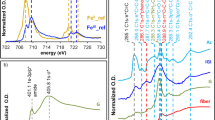Abstract
Cellulose in historic paper documents is often damaged by the writing media used, especially iron gall ink or copper pigments. Degradation induced by iron gall ink is suggested to be a synergistic process comprising both hydrolytic and oxidative reactions. These processes were studied on very low sample amounts according to the CCOA and FDAM method, i.e. by fluorescence labeling of carbonyl and carboxyl groups in combination with GPC-MALLS, respectively. This study focused on preventive means to stop the deterioration induced by iron gall ink of cellulose and to prevent further damage, keeping in mind that a suitable conservation treatment has to hinder both, hydrolytic and oxidative processes, at the same time. A combination of the complexing agent calcium phytate and calcium hydrogencarbonate in aqueous solution was proved to give optimum results. To gain insight into long term stability, an aging step was performed after treatment and different ink modifications were tested. Recording the molecular weight distributions and the carbonyl group content over time GPC analysis verified for the first time the preventive effect of this treatment. This effect was not only seen for the ink-covered areas, but extended also to areas remote from the ink lines. Ink containing copper ions responded equally positively to the calcium phytate/hydrogencarbonate treatment as the iron gall ink papers did. Gelatine, sometimes used in a similar way due to an alleged cellulose-stabilizing effect did not have a beneficial influence on cellulose integrity when metal ions were present.










Similar content being viewed by others
References
Banik G, Kolbe G, Wouters J (2002) Analytical procedures to evaluate conservation treatments of iron gall ink corrosion. In: la conservation à l’ère du numérique, Paris, pp 205–217
Barrett T, Mosier C (1995) The role of gelatine in paper permanence. JAIC 35:173
Bergerhoff G, Weber R, Wunderlich CH (1991) Über Eisengallustinten. Z anorgan allgem Chem (Kyoto) 598(599):371–376
Emery JA, Schröder HA (1974) Iron-catalyzed oxidation of wood carbohydrates. Wood Sci Technol 8:123. doi:10.1007/BF00351367
Hey M (1981) The deacidification and stabilization of irongall inks. Restaurator 1/2:24
Kolar J, Strlič M (2000) Stabilisation of ink corrosion. In: Brown JE (ed) The iron gall ink meeting, Newcastle Upon Tyne
Kolar J, Strlič M, Budnar M, Malešič J, Šelih VS, Simčič J (2003) Stabilisation of corrosive iron gall inks. Acta Chim Slov 50:763
Kolbe G (2004) Gelatine in historical paper production and as inhibiting agent for iron-gall ink corrosion on paper. Restaurator 25:26. doi:10.1515/REST.2004.26
Lewin M, Mark HF (1997) Oxidation and ageing of cellulose. Macromol Symp 118:715
Mitchell CA (1916) Inks—their composition and manufacture including methods of examination and full list of English patents. Charles Griffin & Company Ltd, London
Neevel J (1995) Phytate: a potential conservation agent for the treatment of ink corrosion caused by irongall inks. Restaurator 16:143
Neevel JG (1999a) Phytate als chemische Inhibitoren von Tintenfraß auf Papier. In: Banik G, Weber H (eds) Tintenfraßschäden und ihre Behandlung. Kohlhammer, Stuttgart, pp 87–111
Neevel JG, Mensch CTJ (1999b) The behaviour of iron and sulphuric acid during iron gall ink corrosion. In: ICOM-CC Lyon 12th Triennial Meeting, Lyon, August 29–September 3, vol 2. James and James, London, 528–533
Potthast A, Röhrling J, Rosenau T, Borgards A, Sixta H, Kosma P (2003) A novel method for the determination of carbonyl groups in cellulosics by fluorescence labeling. Part III: monitoring oxidative processes. Biomacromolecules 4:743. doi:10.1021/bm025759c
Reißland B (1999) Ink corrosion: aqueous and non-aqueous treatment of paper objects—state of the art. Restaurator 20:167
Röhrling J, Potthast A, Rosenau T, Lange T, Borgards A, Sixta H et al (2002a) A novel method for the determination of carbonyl groups in cellulosics by fluorescence labeling. Part II: validation and applications. Biomacromolecules 3:369
Röhrling J, Potthast A, Rosenau T, Lange T, Ebner G, Sixta H et al (2002b) A novel method for the determination of carbonyl groups in cellulosics by fluorescence labeling. Part I: method development. Biomacromolecules 3:359
Shahani C, Hengemihle F (1986) The influence of copper and iron on the permanence of paper. American Chemical Society, Washington, DC
Strlič M, Kolar J, Šelih V-S, Kočar D, Pihlar B (2003) A comparative study of several transition metals in fenton-like reaction systems at circum-neutral pH. Acta Chim Slov 50:619
Williams JC, Fowler CS, Lyon MS, Merrill TI (1977) Metallic catalysts in the oxidative degradation of paper. In: Williams JC (ed) Preservation of paper and textiles of historic and artistic value. American Chemical Society, Washington, DC
Zerdoun Bat-Yehouda M (1983) Les Encres Noires au Moyen Âge. Édition du Centre National de la Recherche Scientifique, Paris
Acknowledgement
We would like to thank Dr. Sonja Schiehser for practical assistance. Dipl. Rest. Gesa Kolbe prepared the sample material, performed the treatment and conducted the accelerated aging procedure. We are grateful for the financial support by PAL GmbH, Leipzig, Germany and by the Austrian Science Foundation (FWF, Grant L188-N11).
Author information
Authors and Affiliations
Corresponding author
Rights and permissions
About this article
Cite this article
Potthast, A., Henniges, U. & Banik, G. Iron gall ink-induced corrosion of cellulose: aging, degradation and stabilization. Part 1: model paper studies. Cellulose 15, 849–859 (2008). https://doi.org/10.1007/s10570-008-9237-1
Received:
Accepted:
Published:
Issue Date:
DOI: https://doi.org/10.1007/s10570-008-9237-1




